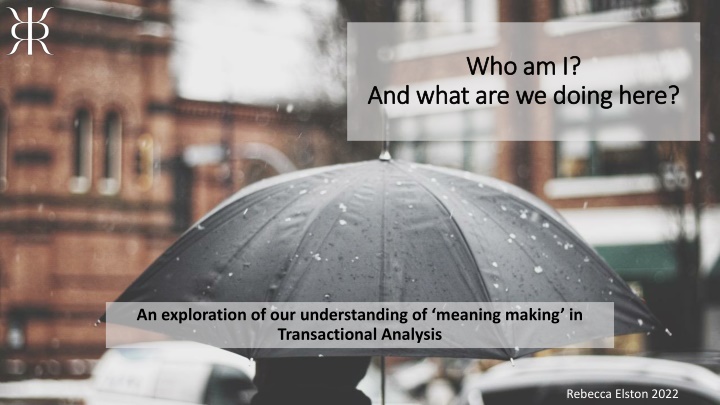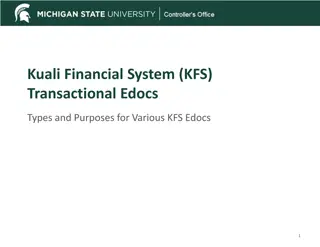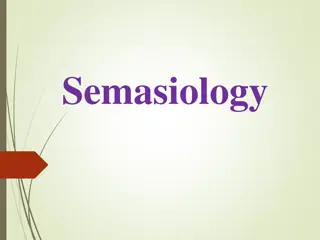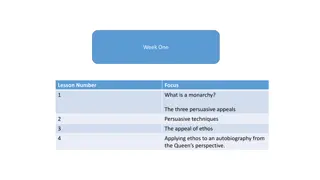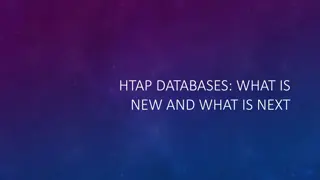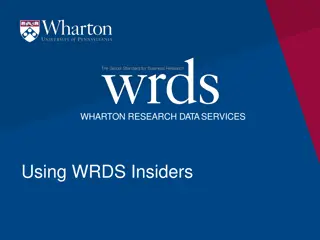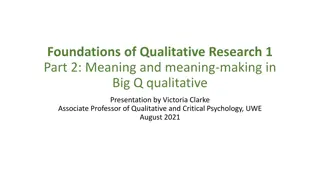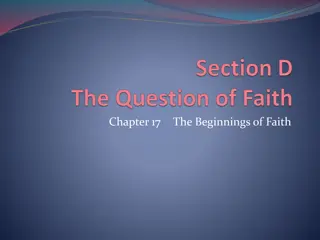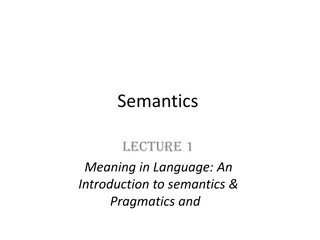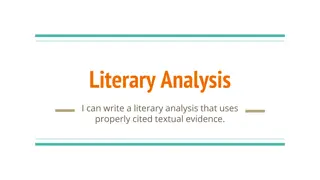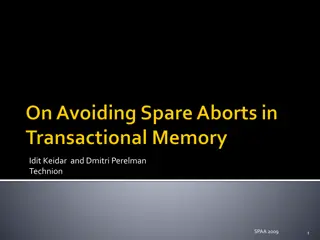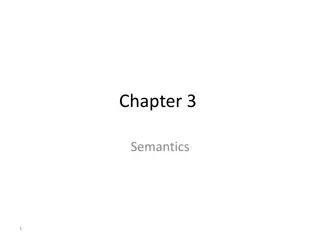Meaning-Making in Transactional Analysis
An exploration of understanding meaning-making in Transactional Analysis by Rebecca Elston in 2022. The discussion revolves around traditional TA concepts, individual connections to place, broadening work frames, and applying Eco TA principles. Key topics include scripts, beliefs about self and others, and the influence of nature-assisted therapy on psychotherapy practice.
Download Presentation

Please find below an Image/Link to download the presentation.
The content on the website is provided AS IS for your information and personal use only. It may not be sold, licensed, or shared on other websites without obtaining consent from the author.If you encounter any issues during the download, it is possible that the publisher has removed the file from their server.
You are allowed to download the files provided on this website for personal or commercial use, subject to the condition that they are used lawfully. All files are the property of their respective owners.
The content on the website is provided AS IS for your information and personal use only. It may not be sold, licensed, or shared on other websites without obtaining consent from the author.
E N D
Presentation Transcript
Who am I? Who am I? And what are we doing here? And what are we doing here? An exploration of our understanding of meaning making in Transactional Analysis Rebecca Elston 2022
Today we will explore A few of the concepts used in our traditional TA approach to understanding individual meaning making Our individual connection to place How we might broaden the frame of our work in TA to account for more than human influence Emerging concept ideas, developed in line with the principals of Eco TA, which support this new frame How we might apply this to our work with clients
Saying Hello Who are you? Where are you from? What are you hoping for from this time today?
Who am I? A Traditional TA Approach One of the key concepts we work with in TA is Script (Berne, 1972). It gives us a common understanding of how a person has come to be who they are based on their subjective meaning making of intrapersonal experiences with primary caregivers. Mother Father You P P P A A A C C C A script is an ongoing life plan formed in early childhood under parental pressure" Berne (1972) Script Matrix - Stewart and Joines (1987)
Who am I? A Traditional TA Approach When working with our clients in TA, to gain an understand about how they are in the world, we often seek to explore their beliefs about: Self Others The World The Script Beliefs and Feelings are all the Parent and Child contaminations of the Adult based upon and supporting script decisions (Erskine & Zalcman 1979)
Personal Reflection 5 minutes Note down your own beliefs about self, other and the world as you know them to be. We will return to this later.
Whats missing is the where? Psychotherapy, has been traditionally an indoor, interpersonal practice. Research is increasingly pointing to the benefits of being connected to nature, learnings from which could enhance our work. A study in San Francisco showed an increase in affective benefits and cognitive benefits when a 50 minute walk was taken in nature, compared to a 50 minute walk in an urban environment (Bratman, Daily, Levy & Gross 2015) A study published in the Scandinavian Journal of Public Health reviewing a collection of studies concluded that there was evidence to support the effectiveness of nature-assisted therapy as a resource for public health, observing improvements in varied diagnoses, spanning from obesity to schizophrenia (Annerstedt &, Wahrborg 2011) Research conducted on behalf of the RSPB found that only 21% of children in the UK felt connected to nature (Hughes, Richardson & Lumber 2018) 95% of adults stating that the intrinsic value of nature in their daily life has been important to them in some way (Countryside Charity Research Paper, 2022)
Break Out Groups - Introductions 10 minutes - Introduce yourselves and share some of your favourite outdoor spaces from childhood to today. What do you like about those places?
Exercise learning from the landscape In your outdoor spaces, take time for the following 30 minute exercise: However feels natural to you. Maybe connect with the breath, use your senses, move or be still. 5 minutes Grounding / Arriving Be part of the space you are drawn to. What do you like about it here? Why is that important to you? What does that mean to you? 10 minutes Finding Your Space What beliefs about yourself apply here? Who do you feel you are in this space? What feels possible? 10 minutes Who Are you Here? What are the similarities and differences between your earlier beliefs and the sense you had of who you were in your space? What meaning do you make of this? Reflection (indoor vs. outdoor) 5 minutes
Questionning the TA Frame of Reference It is important to understand how we have positioned ourselves as beings with interiors who view exteriors, and how these exteriors were positioned as something extrinsic to the selves who viewed them (Jordan, 2015)
Discussion How might we enhance the existing ways we have of working with clients to account for the impact that place has on script?
Evolving how we think about Script The Aggregate Script Helix Self: Made up of all of the influences from others and landscapes, a live and changing structure, responsive to new stimulus Ecological Context P A C P A C Theme: A key area of identity for the individual, made up of all of the ego states of others who the subject has interacted with and made meaning from and the influence and meaning made from experience with landscape Race Sexuality P A C P A C P A C Encounter: The act of self, meeting other in place, resulting in subjective meaning making (the absence of other is as significant as the presence of other) Social Class Self Religion P A C P A C Note: Themes are subjective, I have listed a few common themes which may occur, be curious to the themes of clients individually. The number of themes is also subjective. Gender Ability / Disability Aggregate Script Helix: Elston (2022), Adapted From Script Helix: Summers & Tudor (2000 & 2014)
Challenging the Frame How do we as practitioners ensure that we are constantly checking for that which we might be discounting? Eco therapy research to date is predominantly from Western countries (UK, Europe and US) What do we think of when we imagine landscape ? Romanticised ideas of where we can do this work would exclude many practitioners and clients 66% of the UK population live in predominantly urban locations, however only 4.25 local greenspaces per 1000 people are found in urban areas, contrasting the 29.39 local greenspaces per 1000 people in predominantly rural areas (Countryside Charity Research, 2022) We or our clients may not have a secure relationship with certain landscapes, each individual s experience is different - outdoor work may not be the right type of work for all clients Accessibility, location, disability, safety
What does ecopsychology mean? In Greek, oikosor eco means home, psycheis soul, and logos is the word or story. So a poetic translation might be the story of the home of the soul or the story of the soul of home (Robinson, 2009 see Buzzell & Chalquist)
A Simple Frame The Eco TA Frame of Reference Me When working to understand meaning making, we can begin to identify the level of discounting (Stewart & Joines, 1987) in the client. Us Me There Working outside to inside with the model, we can get a picture in the levels of grandiosity (Schiff, 1971) of thinking present and use the Eco TA Frame of Reference pictured to encourage specificity in the client s thinking. Working towards understanding the meaning made from a single encounter. Us There Them There As is true in the concept of the aggregate script helix, we are always shifting in our perspective, depending on the stimulus in terms of others and landscape and how safe we feel. Them There Eco TA Frame of Reference: Elston (2020)
Frame of Reference in Practice Objectives: 1. Increase specificity moving towards the centre of the Eco TA Frame of Reference 2. Change stimulus Difference in me, others, where allows space to uncover more meaning making material to be understood and processed How: Bringing the outside in, accounting for the where in our indoor work and bringing awareness to the whole encounter Bringing the outside physically inside, external stimulus in the room facilitated by the practitioner, representational objects Framing what is natural in an urban setting is still engaging with the natural (weeds, moss, trees, grass nature survives) There is emerging evidence on the validity of visualization being effective in place of doing , which expands our options even further (Mark Widdowson, 2021)
Postnature is therefore not simply a locking together of separate entities within a passive context rather it is a convergence of mutual interaction and interference involving humans, non- humans and place. (Anderson, 2009)
Contact Rebecca Elston rebecca@reprana.co.uk www.reprana.co.uk
References Anderson, J. (2009). Transient convergence and relational sensibility: Beyond the modern constitution of nature. Emotion, Space and Society, 2, 120-127 Annerstedt, M. & Wahrborg, P. (2011). Nature-assisted therapy: Systematic review of controlled and observational studies, Scandinavian Journal of Public Health, 39, 371-388 Berne, E. (1972). What do you say after you say hello?. New York: Grove Press Bowlby, J. (1988). A Secure Base: Parent-Child Attachment and Healthy Human Development, New York, Basic Books Bratman, G., Daily, C., Levy, B., Gross, J. (2015). The benefits of nature experience: Improved affect and cognition, Landscape and Urban Planning, 138, 41-50 Countryside Charity, Campaign to Protect Rural England (2020). Local Green Space, A Tool for People and Nature s Wellbeing. Available at: https://www.cpre.org.uk/wp- content/uploads/2022/01/Feb-2022_CPRE_Local-Green-Spaces-full-report-1.pdf (Accessed: 26 February 2022) Buzzell, L., Chalquist, C. (2009). Ecotherapy Healing with Nature in Mind, Berkeley: Counterpoint Hughes, J., Richardson, M., Lumber, R. (2018). Evaluating connection to nature and the relationship with conservation behaviour in children, Journal for Nature Conservation, 45, 11-19 Jordan, M. (2015). Nature and Therapy, New York / East Sussex: Routledge Keniger, L., Gaston, K., Irvine, K., Fuller, R. (2013). What are the Benefits of Interacting with Nature?, International Journal of Environmental Research and Public Health, 10, 913-935 Steiner, C. (1966). Script and Counterscript, Transactional Analysis Bulletin, 5, 18, 133-135 Schiff, J. (1971). Passivity. Transactional Analysis Journal, 1:1, 71-78 Schiff, J. (1975). Cathexis Reader: Transcational Analysis Treatment of Psychosis. New York: Harper Row Stewart, I. & Joines, V. (1987). TA Today A New Introduction to Transactional Analysis. Melton Mobray & Chapel Hill, North Carolina: Lifespace Publishing Summers, G. & Tudor, K. (2000). Co-Creative Transactional Analysis. Transactional Analysis Journal, 30:1, 23-40. Tudor, K. (2011). Empathy: A Cocreative Perspective. Transactional Analysis Journal. 41:4, 322-335 Widdowson, M. (2021). Ego States and Their Relevance to Working with Trauma. Workshop Material
